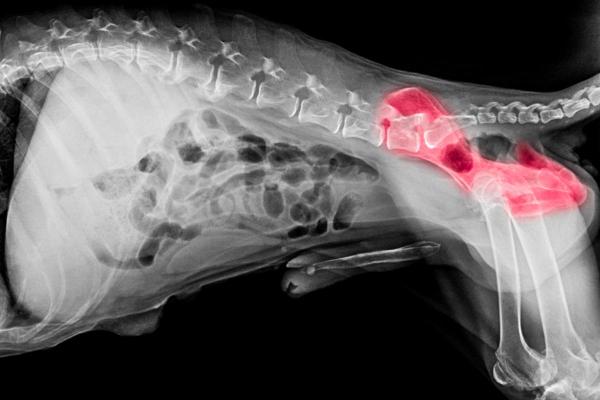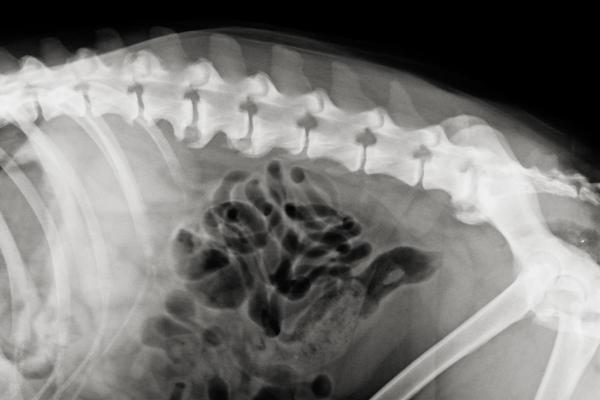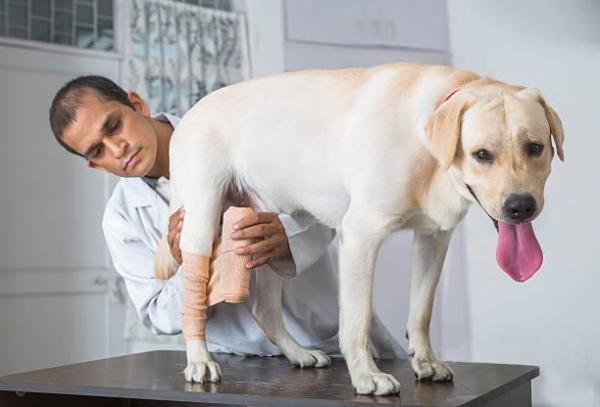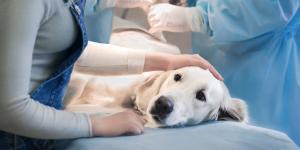Why Can't My Old Dog Use Their Hind Legs?



See files for Dogs
Is your senior dog struggling to walk? One of the most common signs of aging in dogs is weakness or difficulty using their hind legs. This can be caused by a variety of factors, ranging from wear-and-tear conditions like arthritis to injuries or even neurological problems. In this sense, early diagnosis and treatment are crucial for helping your dog maintain a good quality of life.
This article from AnimalWised will explore the 9 common causes of hind leg weakness in senior dogs, along with the different treatment options available in each case.
Trauma or injury
Senior dogs are more susceptible to injuries due to weakened bones and muscles. Falls, accidents, or rough play can damage various structures in the hind legs, leading to weakness and difficulty walking. Here are some specific examples:
- Fractures: broken bones in the hips, legs, or paws can cause severe pain and make it impossible for your dog to put weight on the affected leg.
- Dislocations: when a bone pops out of its joint, it can cause instability, pain, and difficulty walking. Dislocations can occur in the hips, knees, or ankles.
- Torn ligaments: ligaments connect bones and provide stability in the joints. Tears in the ligaments can cause instability, weakness, and pain in the affected leg. Cruciate ligament tears are a common injury in dogs, especially larger breeds.
- Muscle strains or tears: strains and tears in the muscles of the hind legs can cause pain, weakness, and difficulty walking.
If you suspect your dog's limping is due to trauma, act quickly and look for these other signs:
- Sudden onset of limping or difficulty walking
- Yelping or whining when trying to bear weight on a leg
- Visible swelling or bruising on the leg
- Deformity or abnormal position of the leg
- Loss of appetite or lethargy
What to do?
If you notice any of these signs in your senior dog, it's important to take them to the veterinarian immediately for diagnosis and treatment. Early diagnosis and treatment can help prevent long-term problems and improve your dog's recovery. The vet may perform an X-ray to determine the severity of the issue and rule out possible fractures.
Hip dysplasia
Hip dysplasia is a common developmental disorder of the hip joint that can affect dogs of all ages, but it's especially problematic for senior dogs.
In this condition, the ball and socket joint of the hip doesn't form properly, causing looseness in the joint, which leads to pain, inflammation, and eventually arthritis. This condition is a primary cause of hind leg weakness in older dogs, particularly in larger breeds, and it is often hereditary.
Common signs of hip dysplasia in senior dogs include:
- Limping or difficulty walking
- Difficulty rising
- Reduced range of motion
- Grinding or popping sounds
- Muscle atrophy
What to do?
If you notice any of these signs in your senior dog, it's important to take them to the veterinarian for a diagnosis. Early diagnosis and treatment can help slow the progression of hip dysplasia and improve your dog's quality of life. Treatment options may include:
- Chondroprotectors and NSAIDs: these medications help manage pain and inflammation.
- Hip support: using a hip brace or support to stabilize the joint.
- Weight management: involves preventing obesity to reduce stress on the joints.
Preventive surgery can be considered for puppies of predisposed breeds, such as German Shepherds, to reduce the likelihood of hip dysplasia developing as they age.
Looking for ways to help your dog with hip dysplasia? In another article, we explore the most effective exercises to support your dog's mobility and well-being.

Ligament injuries
Ligaments are strong, fibrous tissues that connect bones to other bones, providing stability to joints. Unfortunately, senior dogs are more susceptible to ligament injuries due to weakened connective tissues and potential balance issues. Let us take a closer look at the different types of hind leg ligament injuries, categorized by their severity:
- Sprains: mild stretches or tears in the ligament fibers can cause pain, inflammation, and instability in the joint.
- Partial tears: more severe injuries involve partial tearing of the ligament fibers, resulting in significant pain, limping, and difficulty bearing weight on the affected leg.
- Complete tears: the most severe injuries involve a complete rupture of the ligament, leading to joint instability and rendering the leg unusable. The Cranial Cruciate Ligament (CCL) is a common example of this type of injury in dogs.
What to do?
Treatment options for ligament injuries may include:
- Rest to allow the affected joint to heal.
- Pain medication to manage discomfort and inflammation.
- Splinting to provide support and stability to the injured joint.
- Surgery in the case of severe injuries, where it may be necessary to repair the ligament and restore joint function.
Your veterinarian will recommend the best treatment approach based on the severity of the injury and your dog's overall health.
Arthritis and osteoarthritis
Arthritis and osteoarthritis (OA) are both significant contributors to hind leg weakness in senior dogs, though they have distinct characteristics. Understanding their differences is crucial for effective management.
Arthritis broadly refers to any condition causing inflammation and degeneration of the joints. This can include wear and tear (as seen in osteoarthritis), but also injuries, infections, or other factors. In the hind legs, arthritis can affect the hips, knees, ankles, and even the small joints in the paws. The inflammation and degeneration in these joints can lead to pain, stiffness, and a reduced range of motion.
Osteoarthritis is the most common form of arthritis in dogs, particularly in senior dogs. It is a degenerative joint disease caused by the breakdown of cartilage, the cushioning material between bones. As cartilage deteriorates, the bones start to rub against each other, causing inflammation, pain, and stiffness. Factors contributing to OA include age, repetitive stress, obesity, or previous injuries.
What to do?
Effective management of both arthritis and osteoarthritis includes:
- Achieving and maintaining an ideal weight to reduce stress on the joints.
- Anti-inflammatories and analgesics to alleviate pain and inflammation, and chondroprotectors to support joint health.
- Physiotherapy to improve mobility and strengthen muscles around the affected joints.
As mentioned before, consulting with your veterinarian is essential to develop a comprehensive treatment plan tailored to your dog’s specific needs, ensuring the best possible management of these conditions. Want to know more about dog arthritis? Read our in-depth guide.

Intervertebral disc disease (IVDD)
Intervertebral Disc Disease (IVDD) is a serious condition that can affect dogs of all ages, but it's more common in senior dogs due to age-related degeneration of the spinal discs. These discs are located between the vertebrae in the spine and act as cushions, absorbing shock and providing flexibility.
In IVDD, the intervertebral discs weaken and bulge or rupture. This can put pressure on the spinal cord and nerves, causing a variety of symptoms depending on the location and severity of the disc herniation.
Commonly seen when the disc herniation occurs in the lower back. The dog may drag one or both hind legs, have difficulty walking, or be completely unable to stand. In severe cases, IVDD can compress the nerves that control urination and defecation, leading to incontinence or difficulty eliminating.
What to do?
Early diagnosis and treatment of IVDD are crucial to prevent permanent nerve damage and improve the dog's prognosis. Diagnosis typically involves a combination of physical examination, neurological assessment, and imaging studies like X-rays or MRI.
Mild cases are typically managed with corticosteroids to reduce inflammation and alleviate pain. In severe cases, surgery might be necessary to remove the herniated disc material and relieve pressure on the spinal cord.
Spondylosis deformans
Spondylosis deformans is a degenerative condition of the spine that can affect dogs of all ages, but it's more common in seniors due to wear and tear over time. In this condition, bony growths (osteophytes) develop along the edges and between the vertebrae.
While spondylosis doesn't directly affect the hind legs themselves, it can cause pain and stiffness in the spine, which can indirectly impact a dog's gait and ability to walk normally. This pain and stiffness can make it difficult for your dog to push off with their hind legs when walking, leading to weakness and a reluctance to move.
What to do?
There's no cure for spondylosis, but there are ways to manage the symptoms and improve your dog's quality of life. Treatment options for spondylosis may include pain medication, anti-inflammatory drugs, physical therapy, and acupuncture. By working with your veterinarian, you can develop a treatment plan to help your senior dog manage spondylosis and maintain a good quality of life.
Don't miss our in-depth guide on spondylosis in dogs. This article explores causes, symptoms, treatment options, and even discusses the potential impact on your dog's life expectancy.

Tendinitis
Tendinitis refers to the inflammation of a tendon, often resulting from repeated stress and overloading. If tendinitis affects a key tendon in the hind leg, like the Achilles tendon, it can cause pain and discomfort when the dog tries to push off with their leg. This pain can lead to weakness and a reluctance to bear weight on the affected leg.
Tendinitis is more likely to occur in senior dogs with pre-existing conditions like arthritis or injuries that put extra stress on the tendons.
What to do?
Firstly, rest is crucial to prevent worsening of the condition. Common treatments include anti-inflammatories and analgesics. In severe cases, corticosteroids can be used to reduce severe inflammation. As always, if you notice symptoms of tendinitis or myositis in your dog, consult your veterinarian for an accurate diagnosis and appropriate treatment plan.

Metabolic problems
Some metabolic issues can cause your older dog's hind legs to fail. These include hypothyroidism, hypoglycemia, and hyperadrenocorticism:
- Hypothyroidism: this happens when the thyroid gland doesn't produce enough hormones. It can lead to weight gain, tiredness, hair loss, and weakness in the hind legs.
- Hypoglycemia: low blood sugar can make your dog weak, shaky, and cause its hind legs to fail or lead to frequent falls.
- Hyperadrenocorticism: also known as Cushing's Disease, this condition involves too much cortisol, usually due to a tumor in the adrenal or pituitary gland. Symptoms include increased thirst and urination, a round belly, muscle weakness, and thinning skin, leading to weak hind legs.
What to do?
Each condition has its own treatment. After diagnosing your dog, the vet will recommend the best course of action. Common treatments include:
- Hormone pills in the case of hypothyroidism.
- Glucose supplements and managing the underlying cause in the case of hypoglycemia.
- Medications to lower cortisol or surgery to remove tumors in the case of hyperadrenocorticism.
If you notice any signs of these issues, consult your vet for proper diagnosis and treatment.
Tumors
Another possible reason for your older dog's hind legs failing is the presence of a tumor. Especially in older dogs, tumors in the brain or spine can cause significant problems. These tumors can lead to weakness, incoordination, and difficulty walking. Additionally, your dog may lose appetite and spend more time lying down, which can further weaken the muscles.
What to do?
Treatment depends on the type, location, and condition of the tumor, as well as your dog's overall health. Options may include both surgery and chemotherapy or radiotherapy to shrink the tumor or slow its growth.
As you can see, regular veterinary visits are essential to identify the exact cause of your dog's hind leg weakness. Early diagnosis and treatment can significantly improve your dog's quality of life. Therefore, do not hesitate to make an appointment with your veterinarian as soon as possible.
Do not miss our other article, which provides a more comprehensive exploration of the different types of tumors, their characteristics, and treatment options.
This article is purely informative. AnimalWised does not have the authority to prescribe any veterinary treatment or create a diagnosis. We invite you to take your pet to the veterinarian if they are suffering from any condition or pain.
If you want to read similar articles to Why Can't My Old Dog Use Their Hind Legs?, we recommend you visit our Degenerative diseases category.









